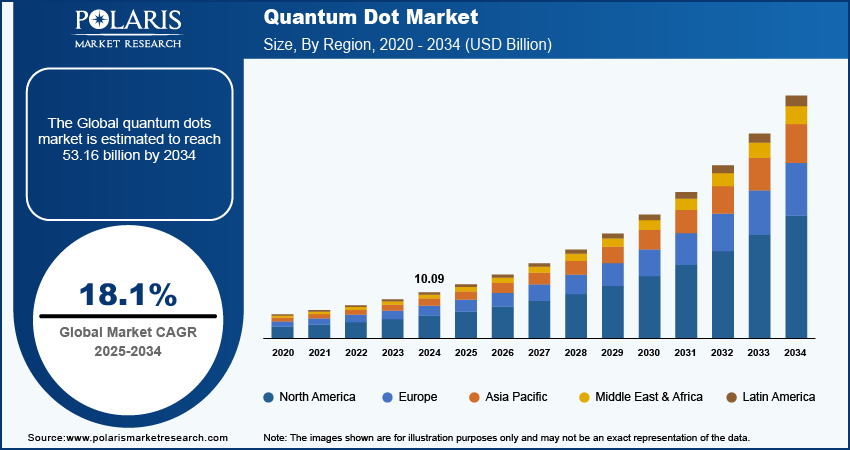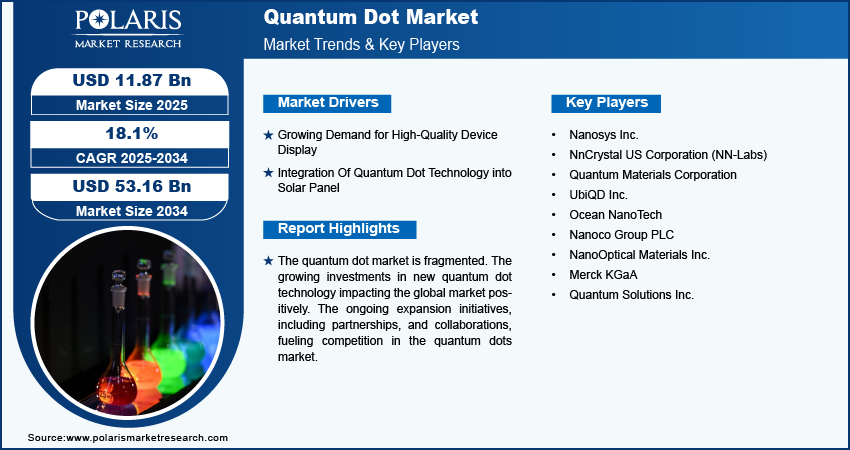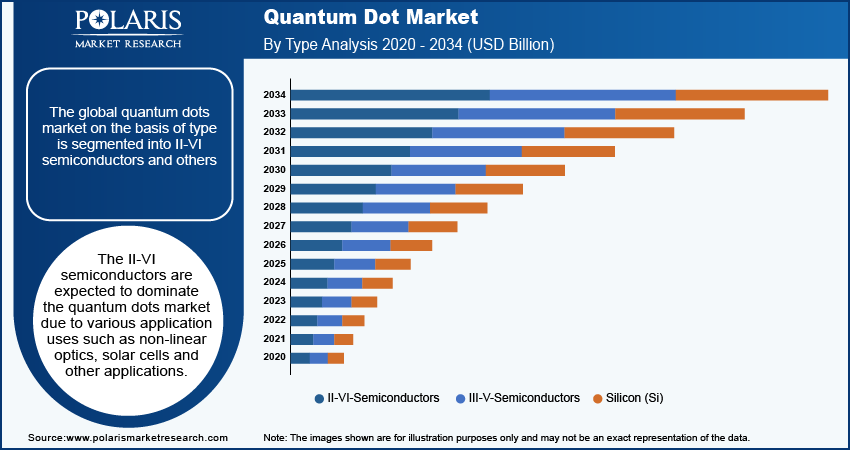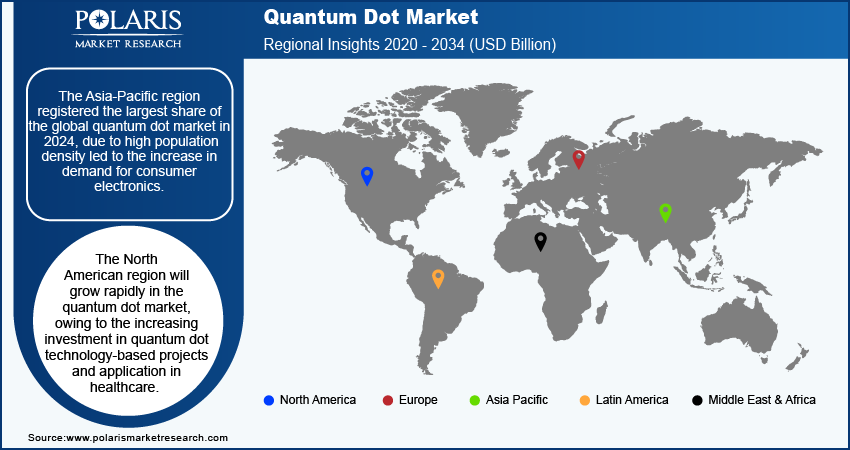
Quantum Dot Market Share, Size, Trends, Industry Analysis Report,
By Material (Cadmium-Based, Cadmium-Free); By Product; By Display Technology (QD-LCDs, Mini-LEDs, QD-OLEDs); By Application; By Region; Segment Forecast, 2024 - 2032
- Published Date:Jun-2024
- Pages: 117
- Format: PDF
- Report ID: PM4971
- Base Year: 2023
- Historical Data: 2019-2022
Report Outlook
Quantum dot market size was valued at USD 8.95 billion in 2023. The market is anticipated to grow from USD 10.57 billion in 2024 to USD 40.45 billion by 2032, exhibiting the CAGR of 18.3% during the forecast period
Quantum Dot Market Overview
The quantum dot market is witnessing rapid growth owing to its increased use in various industries, as photons can be effectively converted into electronic signals by tiny, solution-processable semiconductor nanoparticles called quantum dots. Quantum dots are nanoscale semiconductor nanocrystals exhibiting quantum size effects in their optical and electrical characteristics. QDs typically have the formula MX, where X might be tellurium (Te), selenium (Se), or Sulphur (S). Typically, M stands for cadmium (Cd) or zinc (Zn). Quantum dots are frequently coated with a second MX alloy to produce highly tuned characteristics in the shell and core of the quantum dots. Advances in quantum dots have led to increased awareness among manufacturers and industrialists, hence attracting investments to utilize the quantum dots to their full potential.

To Understand More About this Research:Request a Free Sample Report
- For instance, in January 2024, The Groningen-based company QDI Systems received €5 million in funding to broaden the use of quantum dots technology in medical X-ray imaging.
Moreover, thin-film photovoltaic technologies and energy-efficient technologies are widely used for a wide range of industrial and residential applications, including consumer electronics, space, and military. The need for highly flexible and eco-friendly products has also risen as a key consequence of establishing several regulations and strict energy norms that have positively influenced the global market.
- the lower productivity of the product compared to other alternatives and the negative impact of these solar cells on the environment that forced governments to impose several regulations are the key factors hampering the market growth. Deadly coronavirus worldwide has haled the manufacturing of quantum dot due to imposed locks and other restrictions on trade activities. During the pandemic, many companies halted their operations because of less workforce and a slow sales decline, as several utilities and commercial projects were on hold.
Quantum Dot Market Dynamics
Market Drivers
- Rising Advances in Quantum Dots as Photo Catalysts
There has been a rising advancement in photo catalysis using the quantum dots due to its ability to address both the energy crisis and environmental pollution. The remarkable benefits of semiconductor quantum dots in photocatalysis have garnered a lot of investments owing to their benefits, such as superior visible light absorption, the multi-excitation effect, the surface effect, and customizable energy bands. For instance, in April 2024, zero-dimensional quantum dots (MQDs) were produced from 2D MXenes because of the quantum size effect; they retain the qualities of MXenes but also perform better. MQDs have exceptional co-catalytic qualities and are frequently employed as co-catalysts of photo catalysts due to their exceptional physical and chemical characteristics in antifouling, antifogging, conservation and storage of energy, deodorization, sterilization, self-cleaning, air purification, etc.
- Rising Demand for High-Quality Displays
There is a demand among consumers for high-quality displays to immerse themselves into experiencing advanced displays to elevate their experiences. By producing and remitting brilliant lights, the nanotechnology incorporated in the quantum dots improves the display, displaying a greater range of colors and providing the brightness required to fully utilize technologies like as High Dynamic Range (HDR). The color of the particle depends on its size, which also determines the wavelength of light it emits. Each quantum dot releases a color within a certain bandwidth when it is struck by light. Light from larger dots is skewed more toward red, and light from successively smaller dots is biased more toward green.
Market Restraints
- Complex Manufacturing Processes and Cost-Sensitivity
Quantum dots require intricate production procedures for manufacturing. Further, cost sensitivity makes it challenging to adopt high-quality quantum dots due to the involvement of complex chemical reactions that necessitate exact control over reaction parameters to guarantee the correct size, composition, and optical characteristics. The complexity of these procedures, along with the need for specialized tools and very pure materials, can drive up production prices, impeding the growth of this market.

Report Segmentation
The market is primarily segmented based on material, product, display technology, application and region.
|
By Material |
By Product |
By Display Technology |
By Application |
By Region |
|
|
|
|
|
To Understand the Scope of this Report:Speak to Analyst
Quantum Dot Market Segmental Analysis
By Material Analysis
- The cadmium-based quantum dots dominated the market owing to its wide applications in various industries such as biomedical, optical, electrical, solar power, bio-imaging, bio-sensing, displays, sensors and detectors. Also, the recent advancements with alloyed quantum dots based on cadmium have remarkable properties and characteristics, which can be adjusted by changing the compositional ratio in addition to size management.
- The cadmium-free quantum dots segment is projected to grow at a CAGR during the projected period, mainly driven by their strong performance, environmental advantages, and safety. This rising awareness among manufacturers is increasing the adoption of cadmium-free quantum as it provides a safer and more environmentally friendly option to producers and consumers, giving them the advantage of color without the dangers of toxicity or liability.
By Display Analysis
- The QD-LCDs segment accounted for the largest market share as the quantum dots increase the colour gamut on LCD displays by up to 50 percent. They offer a broad range of colours which enables more saturated colours the vivid, intense colour levels that “pop” on screens and draw viewer attention. Using Quantum Dots means the range of colours and their accuracy is maintained even at peak brightness.
- The Q-OLEDs segment is expected to grow at the fastest CAGR over the next coming years as OLED displays provide excellent visual quality. Every pixel in an OLED is a source of light in and of itself. Super-premium Organic LED displays (OLEDs), displays improved with quantum dots typically cost less and have none of the technological problems or constraints associated with itself and hence driving wide adoption among users.
By Application Analysis
- The healthcare segment dominated the market owing to their wide applications in cellular monitoring, detection, imaging, fluorescence resonance energy transfer (FRET), gene technology, fluorescent labeling, and even the study of tumors and malignancies due to its size and characteristics, QDs are widely used in therapeutic applications including bioimaging, tissue engineering, photothermal therapy, cancer treatment, biosensing, preventing bioterrorism, and most notably, drug delivery.
- The defence segment is experiencing rapid growth with healthy CAGR owing to emission of narrow bands from the quantum dots. These devices operate at very low driving voltages, emit enough power for long-range detection by a range of systems, and may be produced in extremely thin and light form factors. These devices could be used for line-of-sight communications, display backlighting, tagging, and covert illumination, driving the growth of this segment.

Quantum Dot Market Regional Insights
The North America Region Dominated the Global Market with the Largest Market Share
The North America region dominated the market with the largest market share and is expected to maintain its dominance over the anticipated period. The growth of the segment market can be largely attributed to the early adoption of quantum dots technology. Growing public consciousness of fitness and health is expected to drive up demand for QDs in the region for bio-imaging and medical applications. It is anticipated that the North America region will attract significant investment in addition to high caliber research efforts aimed at creating technologically advanced nanoparticles and integrating them into display systems.
The Asia Pacific region is expected to be the fastest-growing region with a healthy CAGR during the projected period, owing to expanding demand from the optical and electronics industry segment. Due to their superior infrastructure and low labor costs, China, Taiwan, and Korea are expected to present major growth prospects for global corporations looking to establish QD R&D sites throughout the area.

Competitive Landscape
The quantum dot market is fragmented and is anticipated to witness competition due to several players' presence. Key players have established research and development facilities to enhance the applications and use quantum dots to their fullest potential. Major service providers in the market are constantly upgrading their technologies to stay ahead of the competition and ensuring efficiency. These players focus on partnership, product upgrades, collaboration, mergers and acquisitions to gain a competitive edge over others to capture a significant market share.
Some of the major players operating in the global market include:
- American Elements
- AUO Corporation
- Avantama AG
- BOE Technology Group Co., Ltd.
- Hansolchemical
- LG Display Co., Ltd.
- Merck KGaA
- Nanoco Group plc
- NNCrystal US Corporation
- SAMSUNG Display
Recent Developments
- In April 2024, UbiQD partnered with First Solar to integrate quantum dots into its solar panels, with the goal of enhancing their energy production.
- In January 2024, Quantum Solutions unveiled the latest addition to their product lineup: QDot Perovskite CsPbBr3 Single Crystals, designed specifically for X-ray sensors in a collaborative effort with AY Sensors, offering a remarkable alternative to the commonly used CdTe and CdZnTe (CZT) crystals in direct X-ray sensors.
Report Coverage
The quantum dot market report emphasizes on key regions across the globe to provide better understanding of the product to the users. Also, the report provides market insights into recent developments, trends and analyzes the technologies that are gaining traction around the globe. Furthermore, the report covers in-depth qualitative analysis pertaining to various paradigm shifts associated with the transformation of these solutions.
The report provides detailed analysis of the market while focusing on various key aspects such as competitive analysis, material, product, display, application, and their futuristic growth opportunities.
Quantum Dot Market Report Scope
|
Report Attributes |
Details |
|
Market size value in 2024 |
USD 10.57 billion |
|
Revenue forecast in 2032 |
USD 40.45 billion |
|
CAGR |
18.3% from 2024 – 2032 |
|
Base year |
2023 |
|
Historical data |
2019 – 2022 |
|
Forecast period |
2024 – 2032 |
|
Quantitative units |
Revenue in USD billion and CAGR from 2024 to 2032 |
|
Segments covered |
By Material, By Product, By Display Technology, By Application, By Region |
|
Regional scope |
North America, Europe, Asia Pacific, Latin America; Middle East & Africa |
|
Customization |
Report customization as per your requirements with respect to countries, region and segmentation. |
FAQ's
Quantum Dot Market report covering key segments are material, product, display technology, application and region.
Quantum Dot Market Size Worth $ 40.45 Billion By 2032
Quantum dot market exhibiting the CAGR of 18.3% during the forecast period.
North America is leading the global market
The key driving factors in Quantum Dot Market are Rising demand for high-quality displays
